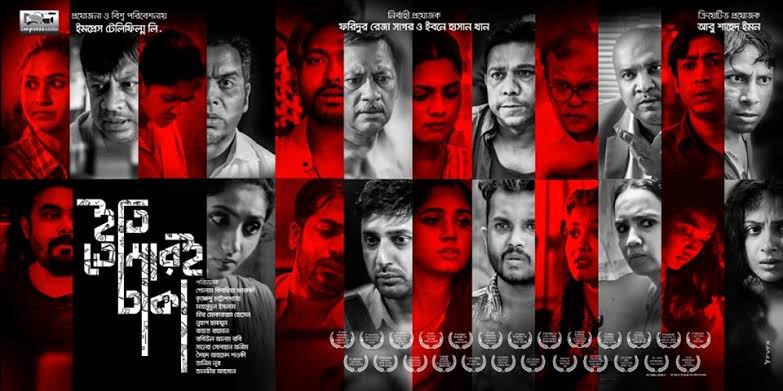The 2018 movie, Sincerely Yours, Dhaka (available on Netflix) is being considered for an Oscar Nomination, so I decided to revive an old piece for the occasion. The post-modern, metropolitan cinematic anthology about Dhaka city, “Sincerely Yours, Dhaka”, is a journey into the shadier, less talked about aspects of its inhabitants and their favorite capital.
The eleven contemporary short stories portray the grey areas of romance, passion, career, culture and society in an almost paradigmatic and casual manner, without romanticizing it. The unlikely combo embodies complicated characters, their complex lives without backstories and hybridized cultures that have bred in the capital for decades, following a grim monotone throughout.
Narrated and created by up and coming Bangladeshi directors Nuhash Humayun, Syed Ahmed Shawki, Rahat Rahman Joy, M.D. Robiul Alam, Golam Kibria Farooki, Mir Mukarram Hossain, Tanvir Ahsan, Mahmudul Islam, Abdullah Al Noor, Krishnendu Chattopadhyay and Syed Saleh Ahmed Sobhan- Sincerely Yours, Dhaka condenses the dimensional unrest, class divide and social atrocities that make the Dhaka city life dynamic to each individual.
The abstractness of the titles, along with the use of low lighting apart from outdoor scenes in daylight sets the mood of a morbid anthology. Some stories have a weaker appeal than the others in terms of direction and narration; however, the delicate themes and strong cinematography makes up for most of it. Unlike other such movies Paris, Je t’aime or New York, I love you, Sincerely Yours, Dhaka is hardly a love letter; it deals more with interpreting the complexities, than spend time justifying them.
Be it the tainted reputation of the Bihari refugees as social outcasts portrayed in Jinnah is Dead, or the over ambitious dreams of a chauffeur attempting to copy his employer’s lifestyle in Maghfirat, we are shown how language, lineage and dreams separate us in a community.
Culturally, much like the “American dream”, people migrate to Dhaka with certain expectations of a metropolitan life which is sometimes marred by misfortune of just being on the wrong end of the invisible hierarchy. The same sentiment is reflected in Background Artist where a struggling actor strives for a permanent role in the industry, even going to extreme measures wherein he pretends to be the father of a tailor’s son for a free costume. The two-dimensional plot reveals how important appearance and class is, when it comes to a child’s education in a good school in Dhaka.
The gloomy, misty lighting and the lack of extensive visual effects helps keep the thematic rawness of the characters intact, as also seen in Cheers- a journey of two friends, searching for liquor in the shadier parts of the city. This short offers two narratives- one, on the challenged independence of females when they are rejected alcohol because of their gender; another, on the toxic nature of modern relationships, laced with emotional abuse and infidelity. Dhaka Metro is given a similar setting, wherein a man, in the face of repeated deceit, brutality and injustice, turns into a car thief to pay for his wife’s surgery.
The transition from each short story, although not crisp, provides a sense of scenic cohesion, except M for Money Murder, which has been done in black and white, narrated and visualized in the form of a flashback; this story, however, does not necessarily reflect the setting, although it makes for a good thriller filler on money fraudulence, similar to Jibon’s Gun depicting the underground mafia scene. Not all of the stories are concluded with finesse or any resolutions, and are at most left at a cliffhanger till the very end.
This literary puncture penetrates the deeper questions about where we stand when it comes to misogyny, judiciary and administrative corruption, which often ends in uncertainty and unresolved cases.
The apparent objectification of Juthi by the hotel staff in assuming she had a non-marital commitment with her partner (Juthi), or Jui getting blackmailed by her former partner that he would personal photos, consolidating in exchange for sex and money (Where, Nowhere), doesn’t go amiss in these narrations; neither does a strange man voluntarily coming to the aid of an estranged woman and rather getting framed as being guilty for abduction and probable harassment (After 12:00 AM).
On the surface, the anthology serves as a bold voice into the darkness and less traveled streets of unparalleled cryptic society, though most of it is far from an honest reality. In effect, the storytellers indeed have created works of fiction which are largely influence by reality, but as shown in Sounds Good, not all looks like what it actually is; the aesthetic amalgamation using peephole vision and ambient dialogues within a makeup unit, along with the grunge background score “Golaper Kata” (Thorns of roses) provides a paradoxical facade of a seemingly immaculate shooting spot.
The conversation reveals a reversed status quo where a single father struggles to choose between his relationship with his daughter and his girlfriend. The coercion of one against the other, the dominance and manipulation created by the man’s status as a celebrity whilst having a stereotypical broken family situation mocks the genre of romantic comedies and post-modernism.
Whether it’s a mother’s quest of justice for her falsely accused son (Where, Nowhere), a man’s desperation for escaping a false sentence by committing the perfect crime (M for Money Murder) or a couple finding it hard to preserve their normalcy against the tantalizing pressures of a typical middle class Bangladeshi family, the anthology succeeds in maintaining its local identity. However, these characters and stories are easily replaceable in any society, and does not necessarily have to be a passive source of the Dhaka life.
The flicks don’t predominantly represent the residents of Dhaka, but rather focuses on the diabolical layers of different personalities who are less talked about in the more prominent depiction of the city.
Somehow, it felt like a lot of what was unsaid should have been brought into a broader perspective, reducing the somberness and emphasizing a little more on characterization than events. Perhaps, in another anthology, a post-script?






















